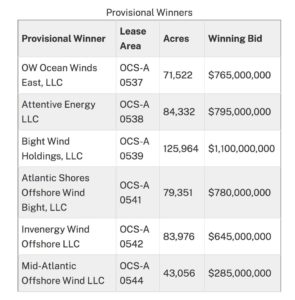Congress Needs to Act to Realize the Jobs Potential of Offshore Wind
The following post is from Rebecca Nowatchik, the Northeast Regional Program Manager for the BlueGreen Alliance.
Earlier this year, the U.S. Department of the Interior announced the results of the New York Bight offshore wind sale. The auctioned area included six lease areas totaling over 488,000 acres and drew competitive winning bids from six companies totaling approximately $4.37 billion. This is a huge deal. The auction made history as the nation’s highest-grossing competitive offshore energy lease sale, including oil and gas lease sales.
The New York Bight is also the first wind lease to include new requirements for developers to demonstrate their goals for procuring materials from U.S.-based manufacturers. It also includes incentives to source major components domestically—blades, turbines, and foundations—and to enter into project labor agreements to promote union-built projects. A project labor agreement is a pre-hire collective bargaining agreement that sets the terms for the workers on the project. It’s a way to make sure jobs are good-paying and safe.
The successful bidders are a mix of companies and groups with roots in wind energy and oil and energy transmission. The table below shows the provisional winners of the lease areas.

Graph from U.S. Department of the Interior.
This lease sale sends a strong message about the future of offshore wind. That message is that we are going to manufacture America’s offshore energy future with American-made products and make sure the jobs building the projects are good, safe, union jobs.
Congressional Action is the Key to Building a Domestic Supply Chain
To ensure we develop a strong, domestic supply chain for the growing offshore wind sector, we must also pass a comprehensive pro-worker, pro-climate budget reconciliation bill. Legislation pending in the Senate could support the development of an offshore wind supply chain in three complementary ways.
First, Congressional action could help increase demand for American-made offshore wind components. This could be accomplished by coupling tax incentives for offshore wind deployment with labor standards and procurement policies that ensure the use of domestic materials and support employers that adopt high-road labor practices—including prevailing wages and utilization of registered apprenticeship. This is important because manufacturers need to see a stable and long-term demand signal for these industries in order to see enough reason to locate facilities here, especially given how far along other countries are the race to build out offshore wind around the world. The bill could extend, strengthen—and make refundable—key clean energy tax credits to help grow a thriving offshore wind industry in the United States. Conditioning some of that incentive on use of domestic content will give manufacturers the signal they need to build out facilities in America.
Second, a strong bill could support capital investment in clean technology manufacturing, including offshore wind. For example, the House-passed Build Back Better Act (BBBA) included $25 billion in investment tax credits under the 48C Advanced Energy Manufacturing program, which provides a credit of up to 30% for investments in building new manufacturing facilities or expanding existing facilities to produce clean energy technologies. The Senate could take similar action and ensure offshore wind manufacturers would be eligible for this credit. Looking forward to an enhanced and expanded program, according to one report, “every $1 billion issued through a new 48C credit program could add $3.6 billion in GDP and roughly 8,000 direct jobs across the country.” But we know capital investment is not enough. Facilitating a strong offshore wind supply chain will also require ongoing support for producing components for the industry.
Third, a bill should provide ongoing production support for manufacturers. This can be done through a new manufacturing production tax credit which will create a incentive for domestic production of offshore wind components. That means manufacturers will receive a set dollar amount of tax credits for each eligible component they produce, including blades, nacelles, towers, and foundations for the offshore wind industry.
A Once-in-a-Generation Opportunity Stands Before Us
offshore wind generation is a once-in-a-generation opportunity for our country. The monumental inclusion of supply chain stipulations for this industry is a win for working people and the first step we needed to get this opportunity right.Right now we are far behind our global competitors in making everything from solar modules to electric vehicle battery cells to offshore wind blades, towers, and foundations. And, until we have robust intentional industrial policies that build out clean energy supply chains in this country we’re not going to get the full benefits of this energy transition.
The choices we make today will determine whether or not American workers will truly benefit from this transition, and whether or not the jobs created by it will be high quality. New industries, like offshore wind, can provide much-needed opportunity not just where the projects are sited but around our nation.
Building a U.S. supply chain that grows along with each phase of offshore wind growth and ensuring that the jobs it supports are good jobs—creating real wealth for American families for generations to come—is an opportunity we cannot afford to pass up. The Senate should move forward with the provisions we outlined to build a strong, domestic offshore wind industry.